Asia Pacific Flash Memory Market Size
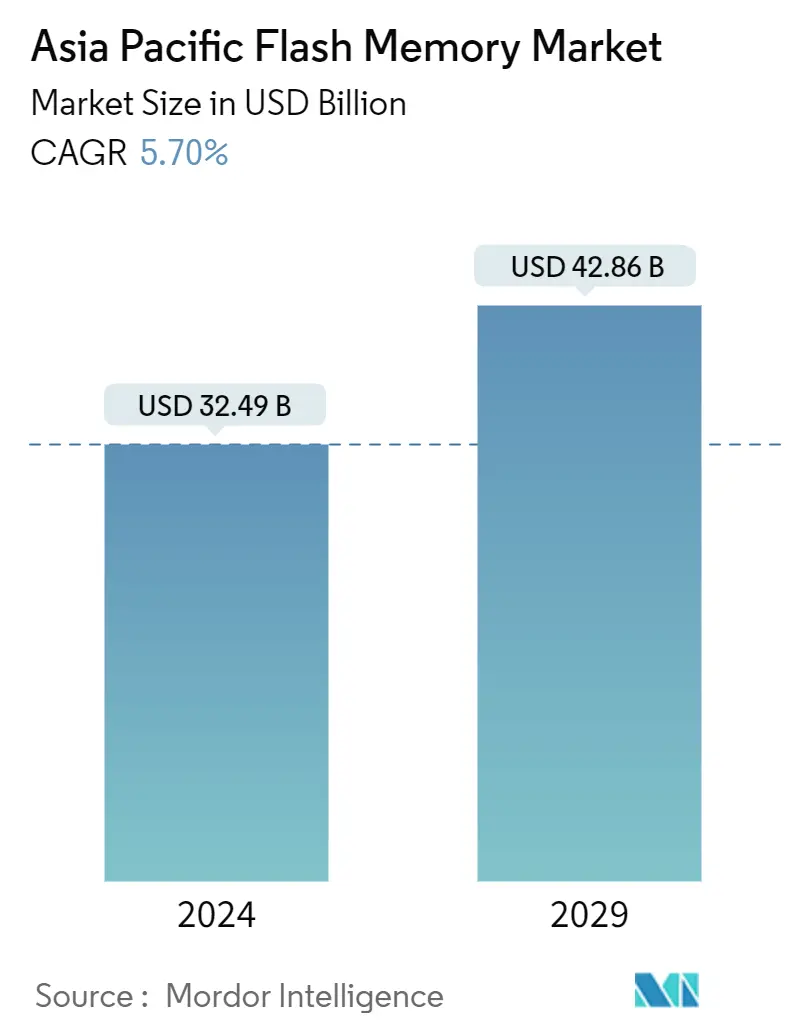
| Study Period | 2019 - 2029 |
| Base Year For Estimation | 2023 |
| Market Size (2024) | USD 32.49 Billion |
| Market Size (2029) | USD 42.86 Billion |
| CAGR (2024 - 2029) | 5.70 % |
| Market Concentration | Medium |
Major Players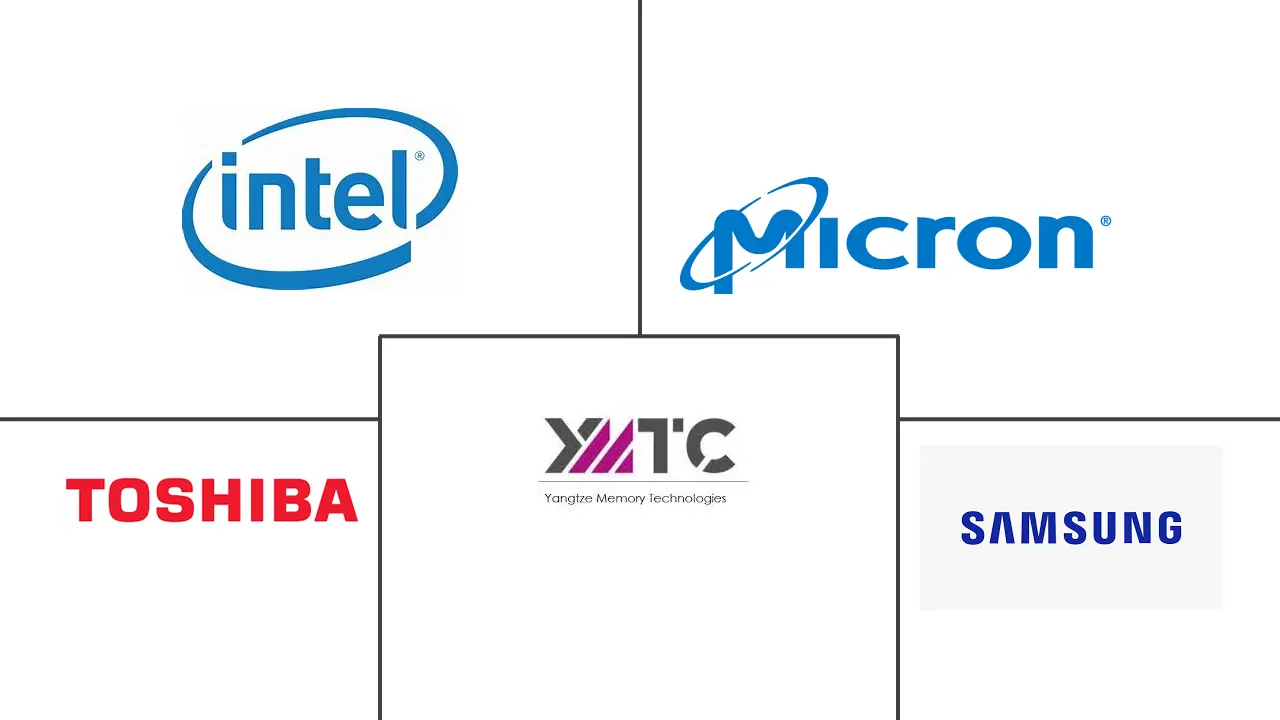
*Disclaimer: Major Players sorted in no particular order |
Need a report that reflects how COVID-19 has impacted this market and its growth?
Asia Pacific Flash Memory Market Analysis
The Asia Pacific Flash Memory Market size is estimated at USD 32.49 billion in 2024, and is expected to reach USD 42.86 billion by 2029, growing at a CAGR of 5.70% during the forecast period (2024-2029).
The growth of the market is favored by various factors, such as growing sales of consumer electronic products, including smartphones, laptops, tablets, and smartwatches, increasing penetration of IoT technology, and the emergence of data-centric applications in numerous industry verticals. China, South Korea, Japan, and India, among others, are major Asian Pacific countries. Asia Pacific is a massive marketplace for non-volatile memory technologies as the area dominates many manufacturing subsectors of other end-user industries and the global semiconductor manufacturing sector. In the market under study, nations like China offer low-cost products.
- Notably, memory manufacturers reported no major impact on flash memory supply in the APAC region, but weakening demand impacted flash memory prices as the electronics device sector was impacted significantly by the COVID-19 outbreak, as China is one of the major suppliers of raw materials and finished products. Moreover, the Indian smartphone manufacturing sector was heavily impacted owing to COVID-19. During the pandemic, smartphone manufacturers such as Samsung, Vivo, Oppo, Motorola, Xiaomi, and LG said they closed their factories for various periods. Apple had also shut down its four sales offices in India and the development center for maps in Hyderabad to prevent coronavirus spread among its employees.
- Furthermore, weakened sales of retail storage products such as memory cards and USB drives were observed, but the demand remained fairly strong in the main application segments owing to the arrival of the traditional peak season and the growth in the procurement related to data centers. The widespread work- and the learn-from-home transition has facilitated a near-term boost to the memory suppliers, leading to first-half memory bit shipments higher than previously anticipated. market
- The flash memory market is growing at a significant rate. New systems and products that are smarter, integrated, all-encompassing, and more economical are contributing to this. Additionally, the gradual acceptance of industry-wide specifications contributed to flash market growth. As a result, the flash industry has grown with the adoption of various interface specifications, especially those relating to the consumer device industry.
- Expanding digital transformation in the region proliferates the demand for data center capacity beyond traditional Tier 1 data centers. Demand in emerging markets such as mainland China, India, and Indonesia continues to gain momentum along with other large emerging markets in Southeast Asia, such as Vietnam and Thailand, coming into view as high-potential markets with burgeoning local needs. Thus, companies in APAC are investing in data center infrastructure management owing to the technology boom and big data, and these new trends are beginning to emerge in the commercial real estate sector, presenting high data storage demand,
- Moreover, the rising disposable income and the growing manufacturing and sales of luxurious automobiles with various features such as ADAS, infotainment, drive video/data recorder, or instrument cluster are further driving the role of flash memory as reported by Toshiba that the average autonomous vehicle is likely to generate data at the rate of 4 terabytes per day, and a significant amount that data will be uploaded to the cloud. The majority of it is likely to sit in flash memory chips residing both on vehicles and in data centers, and the upshot of these trends is a boom time for flash memory chips that can handle the special needs of vehicles.
Asia Pacific Flash Memory Market Trends
NOR Flash Memory Segment is Expected to Hold Significant Market Share
- The rise in the trend of portable electronic devices combined with the growing penetration of advanced technologies, like IoT, among the population across nations such as China, Japan, India, Korea, and others acts as one of the major factors driving the growth of the NOR flash memory.
- Notably, the promise of smart cities has captivated the APAC region's technology industry. As per the recent report by Equinix, 'Smart Cities: Shifting Asia,' UBS projects that APAC will account for 40% of the global addressable market growth for smart city projects, or USD 800 billion, by 2025. This rapid urbanization drives IT buildout and Interconnection Bandwidth growth to sustain APAC's expanding digital market. The region is positioned to expand how AI products think and learn, to build networks of smart cities and hospitals through IoT's enhanced data depth, to help autonomous vehicles process information and make split-second decisions as they learn new roads and situations, to discover new worlds through augmented reality, and to lift communities out of the dark by bringing Big Data to light, which need flash memory to work efficiently.
- Moreover, the growing manufacturing sector in the region will likely provide significant growth opportunities to likelyOR Flash Memory. For instance, according to the Japan External Trade Organization (JETRO), the manufacturing sector in Japan has helped the country rise to one of the largest economies in terms of GDP and to the status of one of the "Manufacturing Superpowers." The Japanese government estimates that the GDP from manufacturing in Japan will increase by 9% from 2020 to 2021, from JPY 108.093 trillion ( USD 0.72 trillion) to JPY 117.790 trillion (USD 0.78 trillion) , and it will reach JPY 119.086 trillion (USD 0.79 trillion) by the end of 2023.
- In addition to automobiles, industrial robots, and other IoT equipment also benefit from the code execution capabilities of NOR flash memory. According to IFR, In 2023 the industrial robot market is expected to grow by 7% to more than 590,000 units globally.
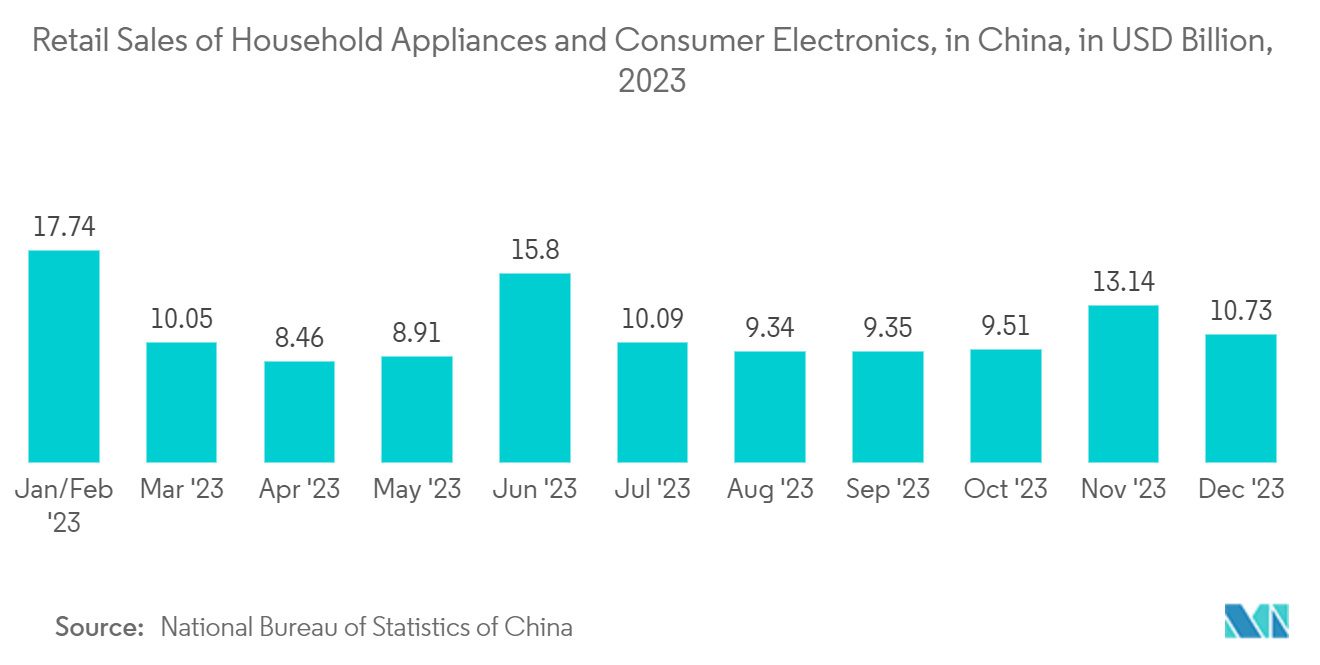
Automotive segment expected to attain significant growth
- Embracing the digital revolution in earnest, leading businesses across sectors today are decisively investing time and effort to enrich their offerings with innovative digital tools. The automotive sector has been no different, with OEMs actively pivoting toward adopting digitized and connected technology to deliver uniquely elevated customer experiences.
- Over the past few years, the demand for Flash memory for automotive applications has consistently risen. The initial uses of Flash included applications like infotainment and engine control. However, with advancements in automotive computerization continuing to progress, flash memory is seeing use in a broader range of various automotive applications. Particularly, there has been a rapid growth in the demand for NOR Flash memory for use in advanced driver-assistance systems (ADAS), digital instrument clusters, and infotainment systems.
- The rising awareness about the importance of ADAS in reducing car accidents is one of the primary factors driving the demand for these systems in recent years. Moreover, government regulation in the automotive industry in various countries directly impacts the way cars look, the design of their components, the safety features incorporated, and the overall performance of any given vehicle. As a result, government regulation also significantly affects the automotive business.
- For instance, in October 2022, the Transport department in India made many amendments to vehicle safety by including various vehicle safety features in two broad categories: active and passive safety. Hence, all carmakers must introduce these safety features to sell their cars in India. These factors have further promoted the role of the need for Electronic Control Units (ECU), which further involves the usage of flash memory.
- Currently, many ADAS applications utilize cameras to assist drivers in identifying nearby hazards. Sensing cameras help provide drivers with automated collision avoidance, lane changing, parking, and more applications. The use of sensing cameras is expected to expand, with cars becoming increasingly autonomous. As sensing cameras need even more complex processing than viewing cameras, highly-efficient SoCs are expected to support this advanced technology. The demand for high-density and high-performance Flash Memory will likely continue to grow in conjunction with this increase in program size.
- The surge in electric vehicles (EV) and hybrid vehicles, accompanied by the emergence of Graphic Instrument Cluster (GIC), infotainment systems, and fully autonomous driving solutions, has created a need for the flash memory market. According to AIRIA (Japan), In 2023, in Japan, the number of electric passenger vehicles in use is approximatly 162.39 thousand, displaying an increase over the past decade.
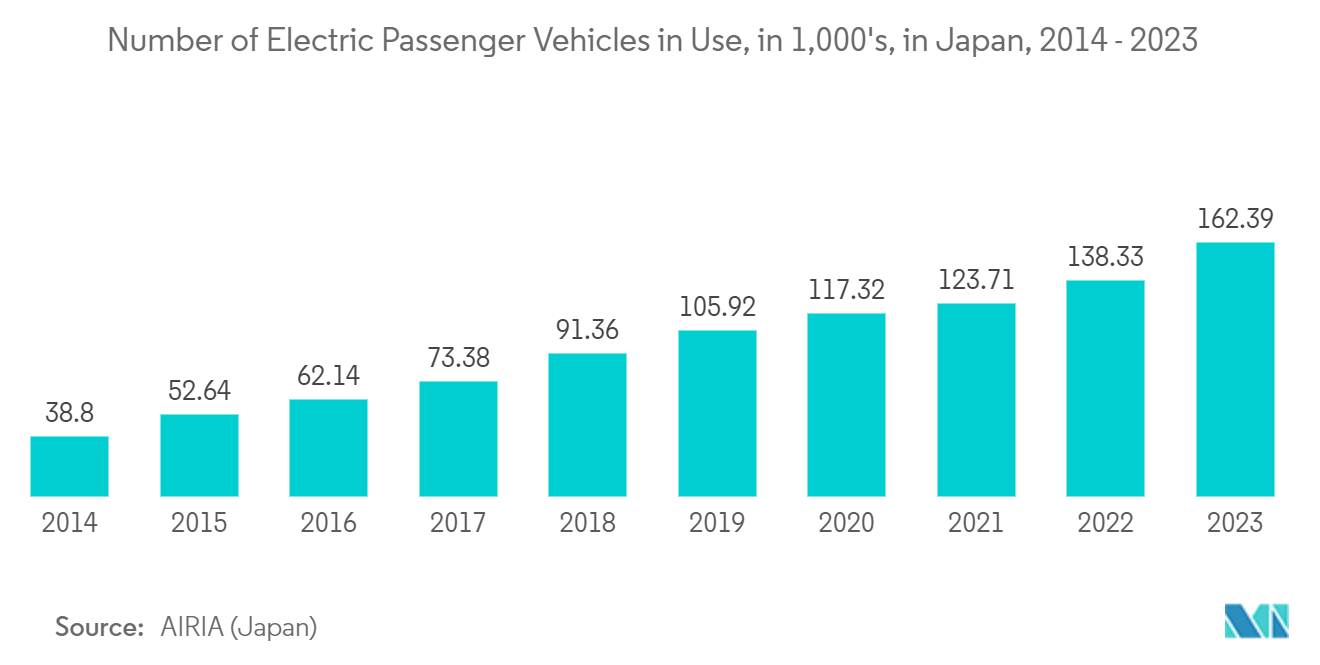
Asia Pacific Flash Memory Industry Overview
The Asia Pacific Flash Memory market, is semi-consolidated, with major vendors such as Samsung Group, Toshiba International Corporation, and SK Hynix Semiconductor, Inc dominating the market. High entry barriers make it difficult for new players to enter the market. Existing vendors are investing heavily in researching and developing new and innovative products.
In January 2023, U.S.-based Western Digital announced the resumption of talks with Japan's Kioxia Holdings to finalize a deal that could unite two technology storage providers. While the structure of a potential deal remains fluid, the parties have been discussing merging into one publicly traded company to make a joint venture that produces flash chips.
In August 2022, Samsung Electronics unveiled an array of next-generation memory and storage technologies during Flash Memory Summit 2022, in a keynote titled "Memory Innovations Navigating the Big Data Era." Samsung spotlighted four areas of technological advancement driving the big data market, which includes data movement, data storage, data processing and data management and showcased how its leading-edge memory solutions addressing each field.
In July 2022, Sahasra Semiconductors Pvt Ltd from Rajasthan, India, announced moving from importer and distributor of memory chips to manufacturing its own branded NAND flash devices. The company is spending about 7.5 billion rupees (about USD 94 million) on setting up an assembly, test, marking, and packaging (ATMP) unit at Bhiwadi that will take in wafers and produce chips.
Asia Pacific Flash Memory Market Leaders
Samsung Group
Toshiba International Corporation
Micron Technology, Inc.
Infineon Technologies AG
Yangtze Memory Technologies Co., Ltd
*Disclaimer: Major Players sorted in no particular order
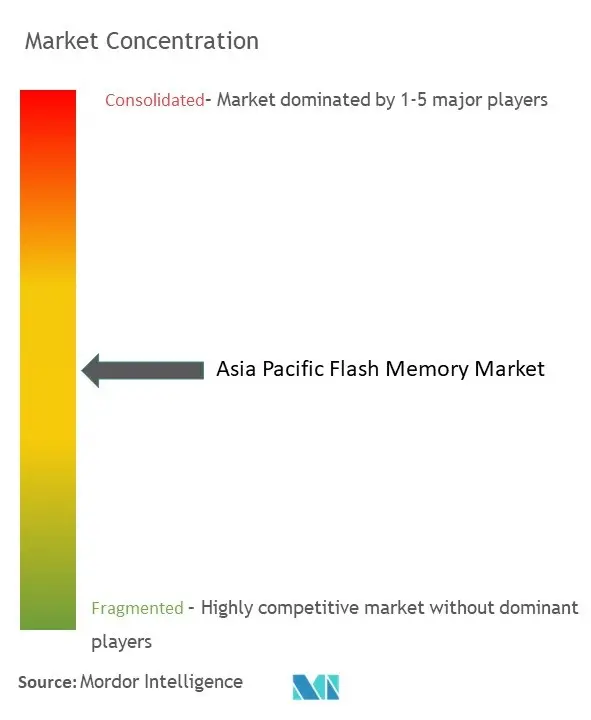
Asia Pacific Flash Memory Market News
- November 2023: The Huawei Asia Pacific Partners Conference 2023 was held in Shenzhen. The Conference championed an open mindset, bringing together Huawei's partners and customers in the ICT industry across the Asia-Pacific region. During the event, Huawei launched a series of new products and solutions for the area, such as intelligent cloud networks and storage products.
- March 2023: Western Digital WDC and Kioxia Corporation announced their joint collaboration to introduce their latest 3D flash memory technology made through advanced scaling and wafer bonding technologies. This technology is suitable for managing exponential data expansion and data-centric applications, such as IoT devices, smartphones, and data centers. This new product is the eighth-generation BiCS FLASH, which reportedly has the industry's highest bit density owing to its 218-layer 3D flash that leverages 1Tb triple-level-cell as well as quad-level-cell with four planes that have helped the company to improve bit density by more than 50%,
Asia Pacific Flash Memory Market Report - Table of Contents
1. INTRODUCTION
1.1 Study Assumptions and Market Definition
1.2 Scope of the Study
2. RESEARCH METHODOLOGY
3. EXECUTIVE SUMMARY
4. MARKET INSIGHTS
4.1 Market Overview
4.2 Supply Chain Analysis
4.3 Impact of macro trends (post-COVID-19 scenario, supply chain disruptions, and economic uncertainties among others) on the Market
4.4 Industry Attractiveness - Porter's Five Forces Analysis
4.4.1 Threat of New Entrants
4.4.2 Bargaining Power of Buyers/Consumers
4.4.3 Bargaining Power of Suppliers
4.4.4 Threat of Substitute Products
4.4.5 Intensity of Competitive Rivalry
5. MARKET DYNAMICS
5.1 Market Drivers
5.1.1 Growing Demand for Data Centers
5.1.2 Growing Applications of IoT
5.2 Market Restraints
5.2.1 Reliability Issues
6. MARKET SEGMENTATION
6.1 By Type
6.1.1 NAND Flash Memory
6.1.1.1 By Density
6.1.1.1.1 128 MB & LESS
6.1.1.1.2 512 MB & LESS
6.1.1.1.3 2 GIGABIT & LESS (greater than 1GB)
6.1.1.1.4 256 MB & LESS
6.1.1.1.5 1 GIGABIT & LESS
6.1.1.1.6 4 GIGABIT & LESS (greater than 2GB)
6.1.2 NOR Flash Memory
6.1.2.1 By Density
6.1.2.1.1 2 MEGABIT & LESS
6.1.2.1.2 4 MEGABIT & LESS (greater than 2MB)
6.1.2.1.3 8 MEGABIT & LESS (greater than 4MB)
6.1.2.1.4 16 MEGABIT & LESS (greater than 8MB)
6.1.2.1.5 32 MEGABIT & LESS (greater than 16MB)
6.1.2.1.6 64 MEGABIT & LESS (greater than 32MB)
6.1.2.1.7 Others
6.2 By End User
6.2.1 Data Center (Enterprise and Servers)
6.2.2 Automotive
6.2.3 Mobile & Tablets
6.2.4 Client (PC, Client SSD)
6.2.5 Other End-user Applications
7. COMPETITIVE LANDSCAPE
7.1 Company Profiles
7.1.1 Samsung Group
7.1.2 Toshiba International Corporation
7.1.3 Micron Technology, Inc.
7.1.4 Infineon Technologies AG
7.1.5 Yangtze Memory Technologies Co., Ltd
7.1.6 Winbond Electronics Corporation
7.1.7 SK Hynix Semiconductor, Inc
7.1.8 Kioxia Corporation
7.1.9 Western Digital Corporation
7.1.10 Intel Corporation
7.1.11 Microchip Technology Inc.
- *List Not Exhaustive
8. MARKET OPPORTUNITIES AND FUTURE TRENDS
9. INVESTMENT ANALYSIS
Asia Pacific Flash Memory Industry Segmentation
Flash memory is a type of non-volatile memory that electronically erases data in blocks and rewrites the data at the byte level. There are two types of flash memory - NOR flash and NAND flash. Flash memory is widely used for storage and data transfer in consumer devices, enterprise systems, and industrial applications. The market study comprises the value and volume of flash memory.
The Asia Pacific Flash Memory Market is segmented by Type (NOR flash memory (by density (2 MEGABIT & LESS, 4 MEGABIT & LESS (greater than 2MB), 8 MEGABIT & LESS (greater than 4MB), 16 MEGABIT & LESS (greater than 8MB), 32 MEGABIT & LESS (greater than 16MB), 64 MEGABIT & LESS (greater than 32MB))), NAND flash memory (by density (128 MB & LESS, 512 MB & LESS, 2 GIGABIT & LESS (greater than 1GB), 256 MB & LESS, 1 GIGABIT & LESS, 4 GIGABIT & LESS (greater than 2GB))), by end user (data center (enterprise and servers), automotive, mobile and tablet, client (PC, client SSD)), other End-user applications). The report offers the market size in value terms in USD for all the above mentioned segments.
| By Type | |||||||||||
| |||||||||||
|
| By End User | |
| Data Center (Enterprise and Servers) | |
| Automotive | |
| Mobile & Tablets | |
| Client (PC, Client SSD) | |
| Other End-user Applications |
Asia Pacific Flash Memory Market Research Faqs
How big is the Asia Pacific Flash Memory Market?
The Asia Pacific Flash Memory Market size is expected to reach USD 32.49 billion in 2024 and grow at a CAGR of 5.70% to reach USD 42.86 billion by 2029.
What is the current Asia Pacific Flash Memory Market size?
In 2024, the Asia Pacific Flash Memory Market size is expected to reach USD 32.49 billion.
Who are the key players in Asia Pacific Flash Memory Market?
Samsung Group, Toshiba International Corporation, Micron Technology, Inc., Infineon Technologies AG and Yangtze Memory Technologies Co., Ltd are the major companies operating in the Asia Pacific Flash Memory Market.
What years does this Asia Pacific Flash Memory Market cover, and what was the market size in 2023?
In 2023, the Asia Pacific Flash Memory Market size was estimated at USD 30.64 billion. The report covers the Asia Pacific Flash Memory Market historical market size for years: 2019, 2020, 2021, 2022 and 2023. The report also forecasts the Asia Pacific Flash Memory Market size for years: 2024, 2025, 2026, 2027, 2028 and 2029.
Asia Pacific Flash Memory Industry Report
Statistics for the 2024 Asia Pacific Flash Memory market share, size and revenue growth rate, created by Mordor Intelligence™ Industry Reports. Asia Pacific Flash Memory analysis includes a market forecast outlook to for 2024 to 2029 and historical overview. Get a sample of this industry analysis as a free report PDF download.
